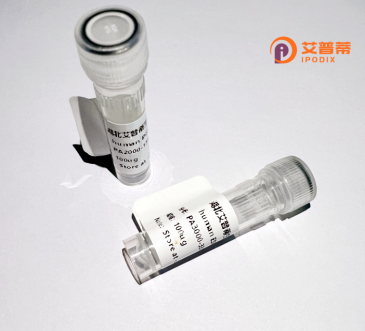
| 纯度 | >90%SDS-PAGE. |
| 种属 | Human |
| 靶点 | KLHL3 |
| Uniprot No | Q9UH77 |
| 内毒素 | < 0.01EU/μg |
| 表达宿主 | E.coli |
| 表达区间 | 1-587aa |
| 活性数据 | MEGESVKLSS QTLIQAGDDE KNQRTITVNP AHMGKAFKVM NELRSKQLLC DVMIVAEDVE IEAHRVVLAA CSPYFCAMFT GDMSESKAKK IEIKDVDGQT LSKLIDYIYT AEIEVTEENV QVLLPAASLL QLMDVRQNCC DFLQSQLHPT NCLGIRAFAD VHTCTDLLQQ ANAYAEQHFP EVMLGEEFLS LSLDQVCSLI SSDKLTVSSE EKVFEAVISW INYEKETRLE HMAKLMEHVR LPLLPRDYLV QTVEEEALIK NNNTCKDFLI EAMKYHLLPL DQRLLIKNPR TKPRTPVSLP KVMIVVGGQA PKAIRSVECY DFEEDRWDQI AELPSRRCRA GVVFMAGHVY AVGGFNGSLR VRTVDVYDGV KDQWTSIASM QERRSTLGAA VLNDLLYAVG GFDGSTGLAS VEAYSYKTNE WFFVAPMNTR RSSVGVGVVE GKLYAVGGYD GASRQCLSTV EQYNPATNEW IYVADMSTRR SGAGVGVLSG QLYATGGHDG PLVRKSVEVY DPGTNTWKQV ADMNMCRRNA GVCAVNGLLY VVGGDDGSCN LASVEYYNPV TDKWTLLPTN MSTGRSYAGV AVIHKSL |
| 分子量 | 64.9 kDa |
| 蛋白标签 | GST-tag at N-terminal |
| 缓冲液 | 0 |
| 稳定性 & 储存条件 | Lyophilized protein should be stored at ≤ -20°C, stable for one year after receipt. Reconstituted protein solution can be stored at 2-8°C for 2-7 days. Aliquots of reconstituted samples are stable at ≤ -20°C for 3 months. |
| 复溶 | Always centrifuge tubes before opening.Do not mix by vortex or pipetting. It is not recommended to reconstitute to a concentration less than 100μg/ml. Dissolve the lyophilized protein in distilled water. Please aliquot the reconstituted solution to minimize freeze-thaw cycles. |
以下是关于重组人KLHL3蛋白的3篇代表性文献概览:
---
1. **文献名称**:*KLHL3 interacts with Cullin3 to form a ubiquitin ligase complex for WNK4 degradation in the kidney*
**作者**:Shibata S, et al.
**摘要**:该研究通过体外重组技术表达并纯化人KLHL3蛋白,发现其与Cullin3结合形成E3泛素连接酶复合物,促进肾脏中WNK4激酶的泛素化降解,从而调节离子稳态与血压。实验揭示了KLHL3在遗传性高血压疾病(如家族性高钾血症,Gordon综合征)中的关键作用。
---
2. **文献名称**:*Structural basis for Cul3 protein assembly with the BTB-Kelch family of E3 ubiquitin ligases*
**作者**:Canning P, et al.
**摘要**:通过X射线晶体学解析重组人KLHL3与Cullin3的复合物结构,阐明Kelch结构域如何识别底物(如WNK激酶),并揭示其氨基酸突变(如与高血压相关的Arg528His突变)如何破坏复合物形成,导致泛素化功能异常。
---
3. **文献名称**:*Functional characterization of KLHL3 mutations in pseudohypoaldosteronism type II*
**作者**:Louis-Dit-Picard H, et al.
**摘要**:研究利用重组人KLHL3蛋白的突变体(如Arg168His和Lys528Arg),在细胞模型中验证其对肾小管细胞钠离子通道(ENaC)的调控功能,发现突变导致KLHL3-Cullin3复合物无法泛素化降解WNK1/4.引发钠钾排泄紊乱,最终导致假性醛固酮减少症II型。
---
这些文献涵盖了KLHL3的结构功能、疾病关联及分子机制研究,建议通过PubMed或Google Scholar输入标题或作者名获取原文。
Recombinant human KLHL3 protein is a genetically engineered form of the endogenous KLHL3 (Kelch-like family member 3) protein, which belongs to the KLHL family of substrate adaptors for Cullin3 (Cul3)-based E3 ubiquitin ligase complexes. KLHL3 contains a BTB domain for Cul3 binding, a BACK domain, and six Kelch repeats that form a β-propeller structure critical for recognizing specific substrate proteins. It plays a key role in regulating electrolyte homeostasis by promoting ubiquitination and degradation of with-no-lysine (WNK) kinases, particularly WNK1 and WNK4. in renal tissues. Dysregulation of KLHL3 is linked to pseudohypoaldosteronism type II (PHAII), also known as Gordon syndrome, a hereditary hypertension disorder caused by mutations in KLHL3 or WNK kinases. Recombinant KLHL3 is widely used to study molecular mechanisms underlying hypertension and kidney dysfunction, drug discovery targeting the WNK signaling axis, and structural analyses of Cul3-KLHL3-substrate interactions. Its production via bacterial or mammalian expression systems enables biochemical studies, including ubiquitination assays and protein-binding kinetics, offering insights into diseases associated with ubiquitin-mediated proteostasis.
×